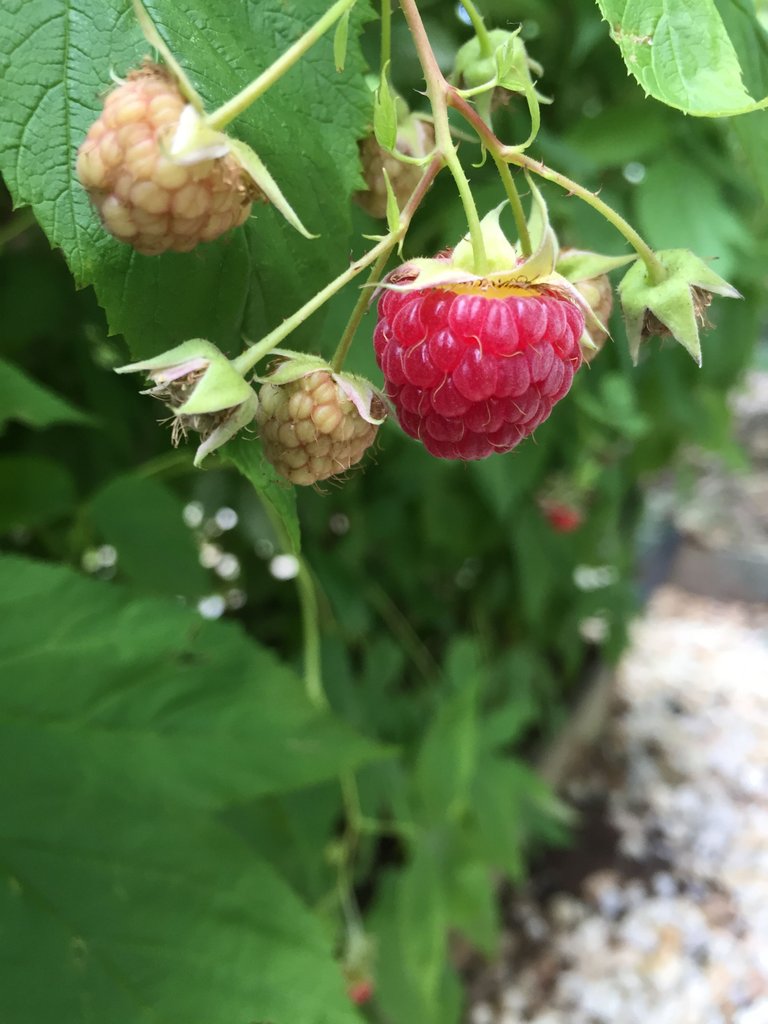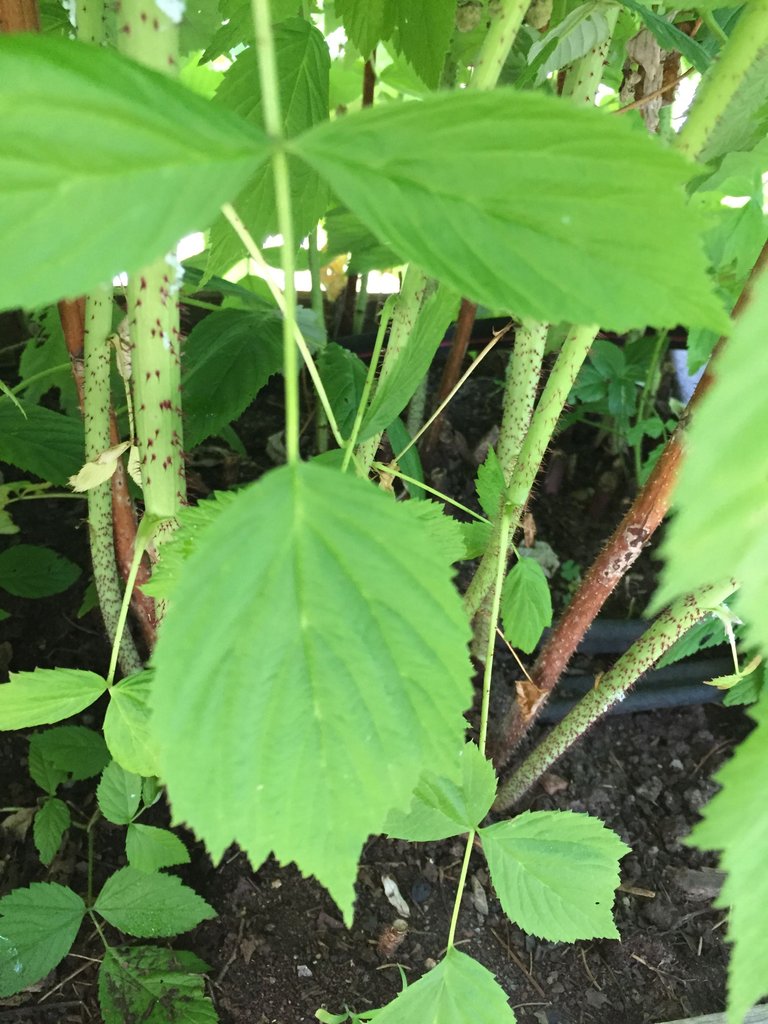I’m in berry heaven right now. Although strawberries have been done for weeks, the blueberries and raspberries have more than made up for it. I’m averaging around a pint every other day for blueberries and today I just picked my first full pint of raspberries.
There are two types of raspberries – Summer-fruiting and Ever-bearing (you can also grow different colors like yellow, purple and black I believe). Summer-fruiting produces once per season and is finished. I’ve never grow that variety so I will focus on the ever-bearing which have been producing nicely for me the past 7 years. Here is what my hedge looked like last month.
The ever-bearing raspberries consist of primocanes and floricanes. Primocanes sprout in the spring and grow all summer producing raspberries at their tops in late summer and early autumn. When they are finished producing the tops should be clipped for the following season. The next year those canes from the prior season become floricanes and produce in June and July. When they are finished they need to be cut at ground level. They will not produce again. Skinny primocanes should be thinned out as well at this time. This cycle should continue for many years as long as you maintain your raspberry hedge.
You can see here the primocanes are generally green and the floricanes brown. This should help when it comes time to cut back the two year old canes.
In the autumn after the raspberries are done producing, in addition to topping the primocanes I usually add some compost if the box looks low, give them a light feeding of fertilizer and apply some leaf mulch. I also thin back any remaining spindly primocanes I missed in the summer when cutting back the floricanes. Also check your PH. It should be on the acidic side like blueberries. Another heavy feeding of fertilizer can be applied in spring.
Raspberry hedges can grow out of control so any canes sprouting in the spring away from your main hedge should be cut. Also it is recommended to install a support system around the hedge to keep all the canes upright and contained. I purchased a box from a garden supply company that came with heavy plastic line and four posts but you can use your imagination and construct something cheaper.
The biggest problem with raspberries for me is Japanese beetles. After years of having my plants and berries eaten, I decided to put a row cover over top and knot it in place to my corner posts.
If you’ve never used these row covers, they let the sun and rain in but keep the insects out. They also help to deter the birds. The downside is the wind can displace the cover so you need to continually re-secure it. The fabric also gets in your way a little when picking and can cause some damage to your taller primocanes. I find any damage is not as bad as what the beetles will cause though. As you can see my berries are thriving under the cover.
Just make sure to remove the cover after your second year canes are done producing so your new canes can pollinate.
Thanks for reading and I hope I’ve motivated some of you to try growing raspberries. I will follow-up to demonstrate the thinning process.









This is a great POST. Thank you. Where about's are you located, as I grow Raspberries and I do not think the Japanese Beetle is here in Canada.
I'm in PA near Philly. Your lucky if you don't have them. They are a menace.
lovely raspberries! I'll have to grow some!
My raspberries didn't produce much this year. I hope it wasn't due to the new location I put them in. It looked like they like it. Full sun for 4 hours and spotted sun for the rest of the day.
Oh well. They are still growing, so maybe a late harvest surprise.
Is it your first year with these canes?
No. Last year was the first year they produced and only one plant produced. It produced a lot. The location wasn't the best for my garden growth, so I moved all the plants into a line on the back of my micro-garden. Every plant group produced about a dozen berries.
Wow I didn't even know you could move them once they got established. I'm sure they are just shocked. Hopefully they will bounce back next year.
Well, they were initially established at the family farm in Michigan and driven down in a hot trunk and then planted in my North Cackalacky micro-garden.
Gorgeous berries and nice haul!
Yes, there are black raspberries... my favorite, especially as jam. They have a taste all their own.
I just read that raspberries will last indefinitely if maintained properly so I may never get a chance to try another variety. If I had space I would grow one of every color.
That would be awesome- a raspberry rainbow! Even if you don't get a chance to grow them, be on the lookout for the jam. At least you'll get a taste of how different they are from the red. ;~D
I feel like I've found my new gardening how-to manual. Your posts -- and your garden -- are fantastic! Thanks for sharing.
Thanks I'm glad to help.
Ugh, Japanese Beetles are a scourge. You might try some French Marigolds. The Japanese Beetles seem to like them in my garden and will gather there rather than on my other plants most of the time. Which makes them easy to gather and drop into soapy water as well, helping to keep the population down. Great post with good info.
Some years we have so many though. My neighbor has a large butterfly bush and they are usually all over that in the month of July. But there are still enough to come attack my raspberries too. I've been keeping them away so far this year with my cover but we probably have 3-4 weeks to go before they go back in the ground.
Oh no! Your neighbor's bush is actually serving as a nearby place for them to converge to breed. I would assume that they aren't doing anything to control them which is bad news for you. You might talk to your neighbor about letting you use an insecticidal soap spray like once a week on their butterfly bush while the beetles are active. If you can keep the population down on the butterfly bush, it may help contain them to the butterfly bush so they aren't spreading to your garden as bad. Might be able to find a recipe for a cheap homemade version of a spray that would help to keep the population at a more reasonable level. The Old Farmer's Almanac has a recipe for one here. Basically just vegetable oil, alcohol, dishwashing detergent (may want to check up on this, pretty sure most of the recipes I've seen say not to use detergent to use dishwashing soap, like Dawn), and water. Just be sure to do a small test patch before spraying the whole plant so you don't end up killing your neighbor's bush.
I've been using neem and sal suds combo on my garden lately and it seems to eo an adequate job controlling cabbage worms, aphids and flea beetles but I haven't tried controlling japanese beetles with it yet.
If I'm not mistaken the Neem interferes with their life cycle rather than killing the adults outright, so it may take some time before you see results with it.
Really good post.
I had raspberries for the last 6 or 7 years in one spot in the garden and after they got established they did very well. I had June bearing plants on one end of the patch and everbearing on the other. I made the mistake of planting a couple of wild raspberry plants in the middle. They basically took over the patch and didn't produce very well. I dug up the patch last year, it was where the greenhouse is now. I gave away a fair amount of the everbearing plants, some to a neighbor and some to my daughter. I planted a few on the back corner of the lot. They lived through the winter and a couple of them are full of flowers now.
With your post, now I understand how the everbearing plants work.
Yes it's nice to know there's a late crop coming. My harvest have not been great with the primocanes though partly from squashing the tall canes with my row cover in the summer and then with the yellow jackets eating them in the fall. I didn't mention that in my article but that's another problem.
Last year I had problems with maggots on the inside of the berries. They looked ok when you picked them, but there would be tiny worms inside the berry. Some kind of bug larvae. It wasn't all of them, mostly just the really ripe ones on the shade side of the plants.
My son found a little worm in one the other day. Now he is sticking with the blueberries.